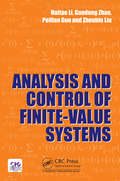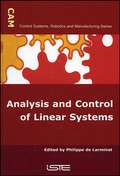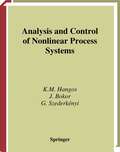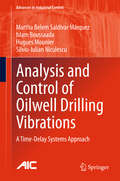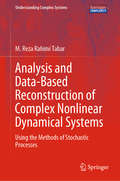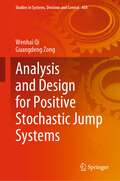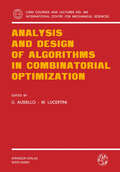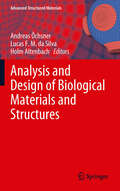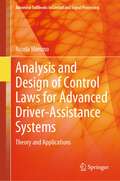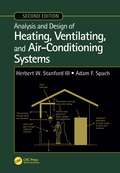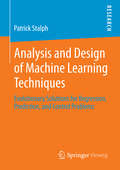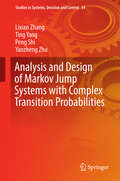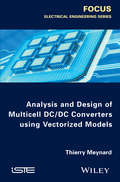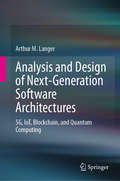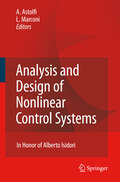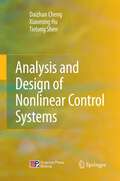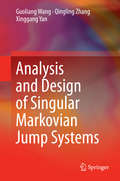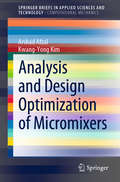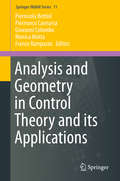- Table View
- List View
Analysis and Control of Finite-Valued Systems
by Haitao Li Guodong Zhao Peilian GuoA comprehensive work in finite-value systems that covers the latest achievements using the semi-tensor product method, on various kinds of finite-value systems. These results occupy the highest position in the analysis and control of this field. It not only covers all aspects of research in finite-value systems, but also presents the mathematical derivation for each conclusion in depth. The book contains examples to provide a better understanding of the practical applications of finite-value systems. It will serve as a textbook for graduate students of Cybernetics, Mathematical, and Biology, and a reference for readers interested in the theory of finite-value systems.
Analysis and Control of Finite-Valued Systems
by Haitao Li Guodong Zhao Peilian GuoA comprehensive work in finite-value systems that covers the latest achievements using the semi-tensor product method, on various kinds of finite-value systems. These results occupy the highest position in the analysis and control of this field. It not only covers all aspects of research in finite-value systems, but also presents the mathematical derivation for each conclusion in depth. The book contains examples to provide a better understanding of the practical applications of finite-value systems. It will serve as a textbook for graduate students of Cybernetics, Mathematical, and Biology, and a reference for readers interested in the theory of finite-value systems.
Analysis and Control of Linear Systems (Control Systems, Robotics, And Manufacturing Ser.)
by Philippe De LarminatAutomation of linear systems is a fundamental and essential theory. This book deals with the theory of continuous-state automated systems.
Analysis and Control of Linear Systems
by Philippe De LarminatAutomation of linear systems is a fundamental and essential theory. This book deals with the theory of continuous-state automated systems.
Analysis and Control of Nonlinear Process Systems (Advanced Textbooks in Control and Signal Processing)
by Katalin M. Hangos József Bokor Gábor SzederkényiThis straightforward text makes the complicated but powerful methods of non-linear control accessible to process engineers. Not only does it cover the necessary mathematics, but it consistently refers to the widely-known finite-dimensional linear time-invariant continuous case as a basis for extension to the nonlinear situation.
Analysis and Control of Oilwell Drilling Vibrations: A Time-Delay Systems Approach (Advances in Industrial Control)
by Martha Belem Saldivar Márquez Islam Boussaada Hugues Mounier Silviu-Iulian NiculescuThis book reports the results of exhaustive research work on modeling and control of vertical oil well drilling systems. It is focused on the analysis of the system-dynamic response and the elimination of the most damaging drill string vibration modes affecting overall perforation performance: stick-slip (torsional vibration) and bit-bounce (axial vibration). The text is organized in three parts.The first part, Modeling, presents lumped- and distributed-parameter models that allow the dynamic behavior of the drill string to be characterized; a comprehensive mathematical model taking into account mechanical and electric components of the overall drilling system is also provided. The distributed nature of the system is accommodated by considering a system of wave equations subject to nonlinear boundary conditions; this model is transformed into a pair of neutral-type time-delay equations which can overcome the complexity involved in the analysis and simulation of the partial differential equation model.The second part, Analysis, is devoted to the study of the response of the system described by the time-delay model; important properties useful for analyzing system stability are investigated and frequency- and time-domain techniques are reviewed.Part III, Control, concerns the design of stabilizing control laws aimed at eliminating undesirable drilling vibrations; diverse control techniques based on infinite--dimensional system representations are designed and evaluated. The control proposals are shown to be effective in suppressing stick-slip and bit-bounce so that a considerable improvement of the overall drilling performance can be achieved.This self-contained book provides operational guidelines to avoid drilling vibrations. Furthermore, since the modeling and control techniques presented here can be generalized to treat diverse engineering problems, it constitutes a useful resource to researchers working on control and its engineering application in oil well drilling.
Analysis and Control of Ultrafast Photoinduced Reactions (Springer Series in Chemical Physics #87)
by Oliver Kühn Ludger WösteThis book summarizes several years of research carried out by a collaboration of many groups on ultrafast photochemical reactions. It emphasizes the analysis and characterization of the nuclear dynamics within molecular systems in various environments induced by optical excitations and the study of the resulting molecular dynamics by further interaction with an optical field.
Analysis and Data-Based Reconstruction of Complex Nonlinear Dynamical Systems: Using the Methods of Stochastic Processes (Understanding Complex Systems)
by M. Reza Rahimi TabarThis book focuses on a central question in the field of complex systems: Given a fluctuating (in time or space), uni- or multi-variant sequentially measured set of experimental data (even noisy data), how should one analyse non-parametrically the data, assess underlying trends, uncover characteristics of the fluctuations (including diffusion and jump contributions), and construct a stochastic evolution equation?Here, the term "non-parametrically" exemplifies that all the functions and parameters of the constructed stochastic evolution equation can be determined directly from the measured data.The book provides an overview of methods that have been developed for the analysis of fluctuating time series and of spatially disordered structures. Thanks to its feasibility and simplicity, it has been successfully applied to fluctuating time series and spatially disordered structures of complex systems studied in scientific fields such as physics, astrophysics, meteorology, earth science, engineering, finance, medicine and the neurosciences, and has led to a number of important results.The book also includes the numerical and analytical approaches to the analyses of complex time series that are most common in the physical and natural sciences. Further, it is self-contained and readily accessible to students, scientists, and researchers who are familiar with traditional methods of mathematics, such as ordinary, and partial differential equations.The codes for analysing continuous time series are available in an R package developed by the research group Turbulence, Wind energy and Stochastic (TWiSt) at the Carl von Ossietzky University of Oldenburg under the supervision of Prof. Dr. Joachim Peinke. This package makes it possible to extract the (stochastic) evolution equation underlying a set of data or measurements.
Analysis and Design for Positive Stochastic Jump Systems (Studies in Systems, Decision and Control #450)
by Wenhai Qi Guangdeng ZongThe book focuses on analysis and design for positive stochastic jump systems. By using multiple linear co-positive Lyapunov function method and linear programming technique, a basic theoretical framework is formed toward the issues of analysis and design for positive stochastic jump systems. This is achieved by providing an in-depth study on several major topics such as stability, time delay, finite-time control, observer design, filter design, and fault detection for positive stochastic jump systems. The comprehensive and systematic treatment of positive systems is one of the major features of the book, which is particularly suited for readers who are interested to learn non-negative theory. By reading this book, the reader can obtain the most advanced analysis and design techniques for positive stochastic jump systems.
Analysis and Design of Algorithms in Combinatorial Optimization (CISM International Centre for Mechanical Sciences #266)
by Giorgio Ausiello M. LucertiniAnalysis and Design of Biological Materials and Structures (Advanced Structured Materials #14)
by Andreas Öchsner, Lucas F. M. F. M. Silva and Holm AltenbachThis collection provides researchers and scientists with advanced analyses and materials design techniques in Biomaterials and presents mechanical studies of biological structures. In 16 contributions well known experts present their research on Stress and Strain Analysis, Material Properties, Fluid and Gas mechanics and they show related problems.
Analysis and Design of Control Laws for Advanced Driver-Assistance Systems: Theory and Applications (Advanced Textbooks in Control and Signal Processing)
by Nicola MimmoAnalysis and Design of Control Laws for Advanced Driver-Assistance Systems (ADAS) teaches students how to solve classical problems in automotive control in a step-by-step fashion. It begins by motivating the use of ADAS and then explains different ADAS models and the goals of their control systems. Systems analysis and control architectures are presented, followed by a treatment of the use of optimal control and the Kalman filter. The author then presents more advanced control techniques and gives an overview of control problems involved in fully autonomous, hybrid and electric vehicles. Each chapter contains a specific discussion of its subject in terms of various ADAS functionalities, such as active suspension, power steering, lane control and automated parking. The text is developed by extensive use of worked examples, related to the applications discussed. Appendices, including necessary aspects of linear algebra and the use of MATLAB render the text self-contained. MATLAB files are provided to help both student and instructor model and analyse the systems being discussed. An electronic solutions manual is freely available for download by instructors adopting the book for their classroom teaching. This textbook will help final-year undergraduate and graduate students to understand the practical issues they will face when working on automotive systems in the real world and the theoretical underpinnings they will need to get to grips with the control systems of present and future generations of cars and other automotive transport. A basic grounding in mathematics and physics is all that is required to get the most from this text.
Analysis and Design of Heating, Ventilating, and Air-Conditioning Systems, Second Edition
by Herbert W. Stanford III Adam F. SpachAnalysis and Design of Heating, Ventilating, and Air-Conditioning Systems, Second Edition, provides a thorough and modern overview of HVAC for commercial and industrial buildings, emphasizing energy efficiency. This text combines coverage of heating and air conditioning systems design with detailed information on the latest controls technologies. It also addresses the art of HVAC design along with carefully explained scientific and technical content, reflecting the extensive experience of the authors. Modern HVAC topics are addressed, including sustainability, IAQ, water treatment and risk management, vibration and noise mitigation, and maintainability from a practical point of view.
Analysis and Design of Heating, Ventilating, and Air-Conditioning Systems, Second Edition
by Herbert W. Stanford III Adam F. SpachAnalysis and Design of Heating, Ventilating, and Air-Conditioning Systems, Second Edition, provides a thorough and modern overview of HVAC for commercial and industrial buildings, emphasizing energy efficiency. This text combines coverage of heating and air conditioning systems design with detailed information on the latest controls technologies. It also addresses the art of HVAC design along with carefully explained scientific and technical content, reflecting the extensive experience of the authors. Modern HVAC topics are addressed, including sustainability, IAQ, water treatment and risk management, vibration and noise mitigation, and maintainability from a practical point of view.
Analysis and Design of Machine Learning Techniques: Evolutionary Solutions for Regression, Prediction, and Control Problems
by Patrick StalphManipulating or grasping objects seems like a trivial task for humans, as these are motor skills of everyday life. Nevertheless, motor skills are not easy to learn for humans and this is also an active research topic in robotics. However, most solutions are optimized for industrial applications and, thus, few are plausible explanations for human learning. The fundamental challenge, that motivates Patrick Stalph, originates from the cognitive science: How do humans learn their motor skills? The author makes a connection between robotics and cognitive sciences by analyzing motor skill learning using implementations that could be found in the human brain – at least to some extent. Therefore three suitable machine learning algorithms are selected – algorithms that are plausible from a cognitive viewpoint and feasible for the roboticist. The power and scalability of those algorithms is evaluated in theoretical simulations and more realistic scenarios with the iCub humanoid robot. Convincing results confirm the applicability of the approach, while the biological plausibility is discussed in retrospect.
Analysis and Design of Markov Jump Systems with Complex Transition Probabilities (Studies in Systems, Decision and Control #54)
by Lixian Zhang Ting Yang Peng Shi Yanzheng ZhuThe book addresses the control issues such as stability analysis, control synthesis and filter design of Markov jump systems with the above three types of TPs, and thus is mainly divided into three parts. Part I studies the Markov jump systems with partially unknown TPs. Different methodologies with different conservatism for the basic stability and stabilization problems are developed and compared. Then the problems of state estimation, the control of systems with time-varying delays, the case involved with both partially unknown TPs and uncertain TPs in a composite way are also tackled. Part II deals with the Markov jump systems with piecewise homogeneous TPs. Methodologies that can effectively handle control problems in the scenario are developed, including the one coping with the asynchronous switching phenomenon between the currently activated system mode and the controller/filter to be designed. Part III focuses on the Markov jump systems with memory TPs. The concept of σ-mean square stability is proposed such that the stability problem can be solved via a finite number of conditions. The systems involved with nonlinear dynamics (described via the Takagi-Sugeno fuzzy model) are also investigated. Numerical and practical examples are given to verify the effectiveness of the obtained theoretical results. Finally, some perspectives and future works are presented to conclude the book.
Analysis and Design of Multicell DC/DC Converters Using Vectorized Models
by Thierry MeynardShows how the concepts of vectorization and design masks can be used to help the designer in comparing different designs and making the right choices. The book addresses series and parallel multicell conversion directly, and the concepts can be generalized to describe other topologies.
Analysis and Design of Multicell DC/DC Converters Using Vectorized Models
by Thierry MeynardShows how the concepts of vectorization and design masks can be used to help the designer in comparing different designs and making the right choices. The book addresses series and parallel multicell conversion directly, and the concepts can be generalized to describe other topologies.
Analysis and Design of Next-Generation Software Architectures: 5G, IoT, Blockchain, and Quantum Computing
by Arthur M. LangerThis book provides a detailed “how-to” guide, addressing aspects ranging from analysis and design to the implementation of applications, which need to be integrated within legacy applications and databases.The analysis and design of the next generation of software architectures must address the new requirements to accommodate the Internet of things (IoT), cybersecurity, blockchain networks, cloud, and quantum computer technologies. As 5G wireless increasingly establishes itself over the next few years, moving legacy applications into these new architectures will be critical for companies to compete in a consumer-driven and social media-based economy. Few organizations, however, understand the challenges and complexities of moving from a central database legacy architecture to a ledger and networked environment.The challenge is not limited to just designing new software applications. Indeed, the next generation needs to function more independently on various devices, and on more diverse and wireless-centric networks. Furthermore, databases must be broken down into linked list-based blockchain architectures, which will involve analytic decisions regarding which portions of data and metadata will be processed within the chain, and which ones will be dependent on cloud systems. Finally, the collection of all data throughout these vast networks will need to be aggregated and used for predictive analysis across a variety of competitive business applications in a secured environment. Certainly not an easy task for any analyst/designer!Many organizations will continue to use packaged products and open-source applications. These third-party products will need to be integrated into the new architecture paradigms and have seamless data aggregation capabilities, while maintaining the necessary cyber compliances. The book also clearly defines the roles and responsibilities of the stakeholders involved, including the IT departments, users, executive sponsors, and third-party vendors. The book’s structure also provides a step-by-step method to help ensure a higher rate of success in the context of re-engineering existing applications and databases, as well as selecting third-party products, conversion methods and cybercontrols. It was written for use by a broad audience, including IT developers, software engineers, application vendors, business line managers, and executives.
Analysis and Design of Nonlinear Control Systems: In Honor of Alberto Isidori
by Alessandro Astolfi Lorenzo MarconiThis book is a tribute to Prof. Alberto Isidori on the occasion of his 65th birthday. Prof. Isidori’s proli?c, pioneering and high-impact research activity has spanned over 35 years. Throughout his career, Prof. Isidori has developed ground-breaking results, has initiated researchdirections and has contributed towardsthe foundationofnonlinear controltheory.In addition,his dedication to explain intricate issues and di?cult concepts in a simple and rigorous way and to motivate young researchers has been instrumental to the intellectual growth of the nonlinear control community worldwide. The volume collects 27 contributions written by a total of 52 researchers. The principal author of each contribution has been selected among the - searchers who have worked with Prof. Isidori, have in?uenced his research activity, or have had the privilege and honour of being his PhD students. The contributions address a signi?cant number of control topics, including th- retical issues, advanced applications, emerging control directions and tutorial works. The diversity of the areas covered, the number of contributors and their international standing provide evidence of the impact of Prof. Isidori in the control and systems theory communities. The book has been divided into six parts: System Analysis, Optimization Methods, Feedback Design, Regulation, Geometric Methods and Asymptotic Analysis, re?ecting important control areas which have been strongly in- enced and, in some cases, pioneered by Prof. Isidori.
Analysis and Design of Nonlinear Control Systems
by Daizhan Cheng Xiaoming Hu Tielong Shen"Analysis and Design of Nonlinear Control Systems" provides a comprehensive and up to date introduction to nonlinear control systems, including system analysis and major control design techniques. The book is self-contained, providing sufficient mathematical foundations for understanding the contents of each chapter. Scientists and engineers engaged in the field of Nonlinear Control Systems will find it an extremely useful handy reference book. Dr. Daizhan Cheng, a professor at Institute of Systems Science, Chinese Academy of Sciences, has been working on the control of nonlinear systems for over 30 years and is currently a Fellow of IEEE and a Fellow of IFAC, he is also the chairman of Technical Committee on Control Theory, Chinese Association of Automation.
Analysis and Design of Singular Markovian Jump Systems
by Guoliang Wang Qingling Zhang Xinggang YanThis monograph is an up-to-date presentation of the analysis and design of singular Markovian jump systems (SMJSs) in which the transition rate matrix of the underlying systems is generally uncertain, partially unknown and designed. The problems addressed include stability, stabilization, H∞ control and filtering, observer design, and adaptive control. applications of Markov process are investigated by using Lyapunov theory, linear matrix inequalities (LMIs), S-procedure and the stochastic Barbalat’s Lemma, among other techniques.Features of the book include:· study of the stability problem for SMJSs with general transition rate matrices (TRMs);· stabilization for SMJSs by TRM design, noise control, proportional-derivative and partially mode-dependent control, in terms of LMIs with and without equation constraints;· mode-dependent and mode-independent H∞ control solutions with development of a type of disordered controller;· observer-based controllers of SMJSs in which both the designed observer and controller are either mode-dependent or mode-independent;· consideration of robust H∞ filtering in terms of uncertain TRM or filter parameters leading to a method for totally mode-independent filtering· development of LMI-based conditions for a class of adaptive state feedback controllers with almost-certainly-bounded estimated error and almost-certainly-asymptotically-stable corresponding closed-loop system states· applications of Markov process on singular systems with norm bounded uncertainties and time-varying delaysAnalysis and Design of Singular Markovian Jump Systems contains valuable reference material for academic researchers wishing to explore the area. The contents are also suitable for a one-semester graduate course.
Analysis and Design Optimization of Micromixers (SpringerBriefs in Applied Sciences and Technology)
by Arshad Afzal Kwang-Yong KimThis book illustrates the computational framework based on knowledge of flow and mass transfer together with optimization techniques to solve problems relevant to micromixing technology. The authors provide a detailed analysis of the different numerical techniques applied to the design of micromixers. Flow and mixing analysis is based on both the Eulerian and Lagrangian approaches; relative advantages and disadvantages of the two methods and suitability to different types of mixing problems are analysed. The book also discusses the various facets of numerical schemes subjected to discretization errors and computational grid requirements. Since a large number of studies are based on commercial computational fluid dynamics (CFD) packages, relevant details of these packages to the mixing problem using them are presented. Numerical optimization techniques coupled with CFD analysis of flow and mixing have proved to be an important tool for micromixers design, and therefore, are an important part of the book. These techniques are presented briefly, and focus is on surrogate modeling and optimization applied to design of micromixers.
Analysis and Evaluation of Public Social Housing: Tools for a Sustainable Regeneration (SpringerBriefs in Applied Sciences and Technology)
by Lorenzo DianaThe book explores current characteristics of the urban built environment in view of possible future transformations. A cross-reading analysis of existing public social housing buildings is proposed, based on the investigation of their architectural, structural, and energetic characteristics. The study aims to provide an integrated approach that captures the link between typology, construction, and energy demands, offering a key to understanding the main critical issues and transformation readiness. It focuses on large-scale interventions composing public social housing stocks, realized during the second half of the twentieth century. More than other public interventions, such building stocks clearly lack in meeting current housing needs such as modern apartment architectural layout, energy and structural regulations, and social mix. However, due to their numerical presence, strategical and widespread distribution across urban areas, and transformability, these buildings can be the target for future strategic regeneration projects. In particular, the book thoroughly investigates the social housing estate constructed in Rome (Italy) after the approval in 1964 of the first urban economic and social housing plan.
Analysis and Geometry in Control Theory and its Applications (Springer INdAM Series #11)
by Piernicola Bettiol Piermarco Cannarsa Giovanni Colombo Monica Motta Franco RampazzoSince the 1950s control theory has established itself as a major mathematical discipline, particularly suitable for application in a number of research fields, including advanced engineering design, economics and the medical sciences. However, since its emergence, there has been a need to rethink and extend fields such as calculus of variations, differential geometry and nonsmooth analysis, which are closely tied to research on applications. Today control theory is a rich source of basic abstract problems arising from applications, and provides an important frame of reference for investigating purely mathematical issues. In many fields of mathematics, the huge and growing scope of activity has been accompanied by fragmentation into a multitude of narrow specialties. However, outstanding advances are often the result of the quest for unifying themes and a synthesis of different approaches. Control theory and its applications are no exception. Here, the interaction between analysis and geometry has played a crucial role in the evolution of the field. This book collects some recent results, highlighting geometrical and analytical aspects and the possible connections between them. Applications provide the background, in the classical spirit of mutual interplay between abstract theory and problem-solving practice.
